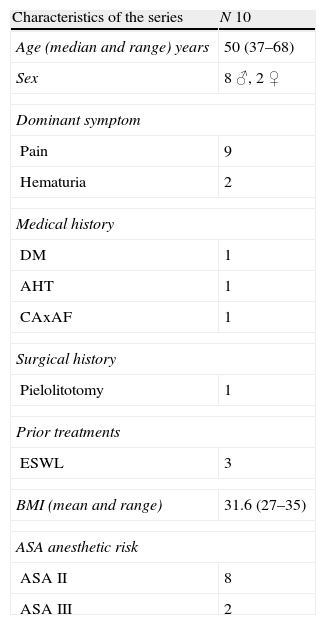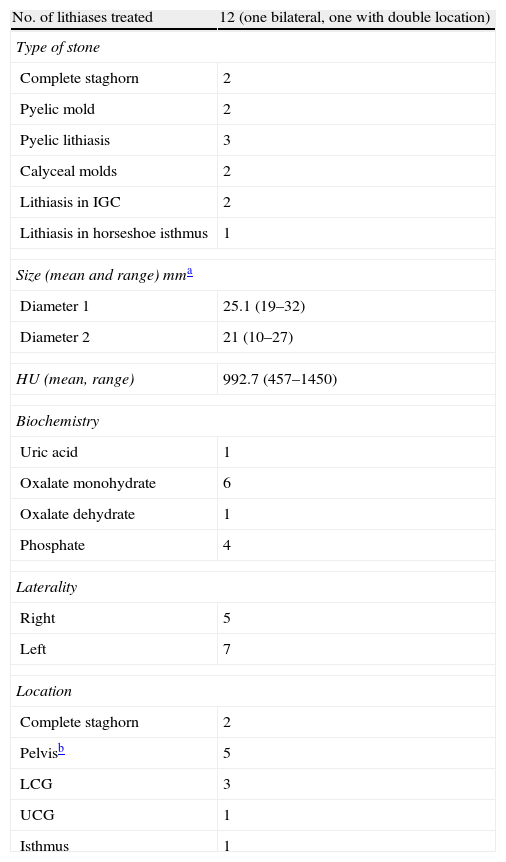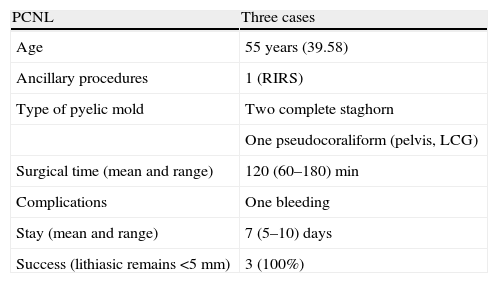To present our centre's experience in the surgical treatment of lithiasis in patients with horseshoe kidney.
Materials and methodsFrom October 2007 to March 2011 we treated 10 patients with renal lithiasis in their horseshoe kidneys. Retrospectively, we reviewed the symptoms, medical and surgical history, the characteristics of the stones (size, location, composition) and treatments that were carried out. In all the cases, the study was carried out by CT, with volume reconstruction and with an angiographic study. A percutaneous nephrolithotomy (PCNL) or an endoscopic retrograde intrarrenal surgery (RIRS) was carried out, depending on the size and location of the stone.
ResultsThree percutaneous nephrolithotomies were carried out (2 on staghorn lithiasis stones, 1 pseudocoraliform stone) with a combined rigid and flexible single-access nephroscopy. In one case there was hemorrhage that required treatment by selective embolization. In the rest, RIRS was carried out, all with stones <30mm in their greatest diameter without any complications. The mean surgical times were 120 (60–180)min for the percutaneous route and 105 (65–160)min for the retrograde route. In all the cases the treatment achieved a complete elimination of the stones or remains of less than 5mm.
ConclusionsThe treatment of renal lithiasis in horseshoe kidneys is complex, given their peculiar anatomy. The usual surgical techniques can be reproduced in these cases with good results. We opt for PCNL in complete staghorn stone and pseudocoraiform stones, whereas RIRS is a valid option in cases with stones <3cm.
Presentar la experiencia de nuestro centro en el tratamiento quirúrgico de la litiasis en pacientes con riñón en herradura.
Material y MétodosDesde octubre de 2007 hasta septiembre de 2011 hemos tratado 10 pacientes con litiasis en riñón en herradura. De forma retrospectiva hemos revisado sintomatología, antecedentes médicos y quirúrgicos, características de la litiasis (tamaño, localización y composición) y tratamientos realizados. En todos los casos se realizó estudio mediante TC con reconstrucción volumétrica y estudio angiográfico. Se realizó nefrolitotomía percutánea (NLPC) o cirugía endoscópica retrógrada intrarrenal (CRIR) en función del tamaño y localización de la litiasis.
ResultadosSe han realizado tres nefrolitotomías percutáneas (dos coraliformes completos, 1 pseudocoraliforme) con un solo acceso combinando nefroscopia rígida y flexible. En un caso se produjo hemorragia que requirió embolización selectiva. En el resto se realizó CRIR, todos con litiasis de <30mm de diámetro mayor, sin ninguna complicación. Los tiempos quirúrgicos medios fueron de 120 (60-180) minutos para la vía percutánea y de 105 minutos (65-160) para la retrógrada. En todos los casos el tratamiento consiguió la eliminación completa de la litiasis o restos de menos de 5mm.
ConclusionesEl tratamiento de la litiasis en los riñones en herradura es complejo dada la peculiar anatomía. Las técnicas quirúrgicas habituales permiten en estos casos buenos resultados. Optamos por NLPC en coraliformes completos y pseudocoraliformes, siendo la CRIR una opción válida en casos con tamaño litiásico de <3cm.











